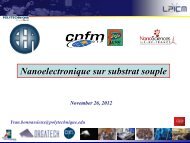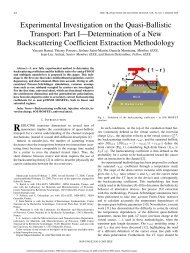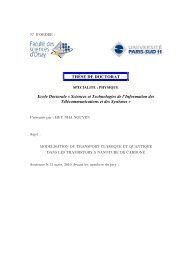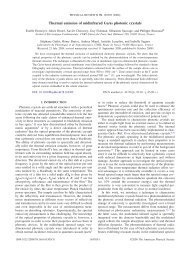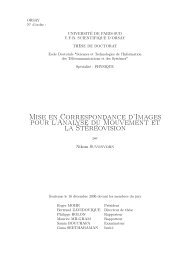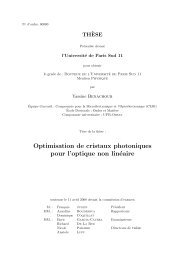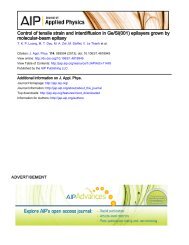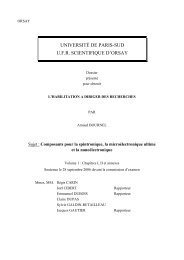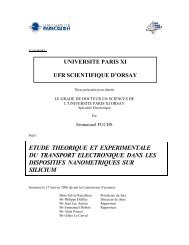Wigner ensemble Monte-Carlo simulation of nano ... - ResearchGate
Wigner ensemble Monte-Carlo simulation of nano ... - ResearchGate
Wigner ensemble Monte-Carlo simulation of nano ... - ResearchGate
Create successful ePaper yourself
Turn your PDF publications into a flip-book with our unique Google optimized e-Paper software.
physicapsswww.pss-c.comstatussolidiccurrent topics in solid state physics<strong>Wigner</strong> <strong>ensemble</strong> <strong>Monte</strong>-<strong>Carlo</strong><strong>simulation</strong> <strong>of</strong> <strong>nano</strong>-MOSFETs in degenerate conditionsD. Querlioz 1 , J. Saint-Martin 1 , V.-N. Do 1,2 , A. Bournel 1 , and P. Dollfus 11 Institut d’Electronique Fondamentale, Université Paris-Sud, CNRS, 91405 Orsay, France2 Theoretical Department, Institute <strong>of</strong> Physics, VAST, P.O. Box 429 Bo Ho, Hanoi 10000, VietnamReceived 9 July 2007, revised 22 August 2007, accepted 22 August 2007Published online 23 October 2007PACS 02.70.Uu, 05.60.Gg, 73.23.-b, 85.30.De, 85.30.Tv<strong>Wigner</strong> quasi-distribution function is an appropriate quantummechanics formulation to study the transition from semiclassicalto quantum transport in <strong>nano</strong>-devices since it can accuratelydescribe quantum transport including the decoherencedue to scatterings. We have recently developed an efficientapproach to solving the <strong>Wigner</strong> transport equation usinga <strong>Monte</strong> <strong>Carlo</strong> (MC) algorithm that has been applied to ResonantTunnelling Diodes and <strong>nano</strong>-MOSFET <strong>simulation</strong>. Theapproach is here extended to incorporate degeneracy effectsthat are important in highly doped MOSFETs. The calculationis compared with Non Equilibrium Green’s Function andthe semi-classical Boltzmann equation. Relative importance<strong>of</strong> quantum transport and decoherent scattering is discussed atlow and room temperatures.phys. stat. sol. (c) 5 , No. 1, 150–153 (2008) / DOI 10.1002/pssc.200776565REPRINT
phys. stat. sol. (c) 5, No. 1, 150–153 (2008) / DOI 10.1002/pssc.200776565psswww.pss-c.com<strong>Wigner</strong> <strong>ensemble</strong> <strong>Monte</strong>-<strong>Carlo</strong><strong>simulation</strong> <strong>of</strong> <strong>nano</strong>-MOSFETs in degenerate conditionsD. Querlioz *,1 , J. Saint-Martin 1 , V.-N. Do 1,2 , A. Bournel 1 , and P. Dollfus 1physica1 Institut d’Electronique Fondamentale, Université Paris-Sud, CNRS, 91405 Orsay, France2 Theoretical Department, Institute <strong>of</strong> Physics, VAST, P.O. Box 429 Bo Ho, Hanoi 10000, Vietnamstatussolidiccurrent topics in solid state physicsReceived 9 July 2007, revised 22 August 2007, accepted 22 August 2007Published online 23 October 2007PACS 02.70.Uu, 05.60.Gg, 73.23.-b, 85.30.De, 85.30.Tv* Corresponding author: e-mail damien.querlioz@ief.u-psud.fr, Phone: +33 1 69 15 41 05, Fax: +33 1 69 15 40 20<strong>Wigner</strong> quasi-distribution function is an appropriate quantummechanics formulation to study the transition from semiclassicalto quantum transport in <strong>nano</strong>-devices since it can accuratelydescribe quantum transport including the decoherencedue to scatterings. We have recently developed an efficientapproach to solving the <strong>Wigner</strong> transport equation usinga <strong>Monte</strong> <strong>Carlo</strong> (MC) algorithm that has been applied to Reso-nant Tunnelling Diodes and <strong>nano</strong>-MOSFET <strong>simulation</strong>. Theapproach is here extended to incorporate degeneracy effectsthat are important in highly doped MOSFETs. The calculationis compared with Non Equilibrium Green’s Function andthe semi-classical Boltzmann equation. Relative importance<strong>of</strong> quantum transport and decoherent scattering is discussed atlow and room temperatures.© 2008 WILEY-VCH Verlag GmbH & Co. KGaA, Weinheim1 Introduction The occurrence <strong>of</strong> quantum transporteffects has <strong>of</strong>ten been considered as a fundamental limit tothe miniaturization <strong>of</strong> Metal Oxide Semiconductor FieldEffect Transistors (MOSFETs), the key foundation <strong>of</strong>modern integrated electronics. In contradiction with thesepredictions, research labs now demonstrate functional transistorswith gate lengths smaller than 10 nm [1–4]. Thequantum character <strong>of</strong> transport is known to play an importantrole in such short MOSFETs. Understanding theirphysics is however difficult since carriers in these devicesstill experience many decoherent scatterings (due e.g. tophonons and interfaces roughness) that disrupt their quantumbehavior.Non Equilibrium Green’s Functions (NEGF) from themany body physics are <strong>of</strong>ten used to understand the physics<strong>of</strong> devices operating in the quantum regime [5–10].However it is difficult to include realistic scattering modelsin the NEGF formalism due to theoretical and computationaldifficulties. In particular, NEGF modeling cannotreadily use all the work that has been accomplished tomodel scatterings in classical electron devices.The <strong>Wigner</strong> quasi-distribution function (WF) can providean original alternative to NEGF. WF is defined as the center-<strong>of</strong>-massFourier transform <strong>of</strong> the density matrix <strong>of</strong> thecarriers, and is most interesting because it shares manysimilarities with a distribution function, although it is notpositive-definite [11]. In fact it tends to the Boltzmann’sequation distribution function in a semi-classical transportsituation. Besides, scattering effects can be incorporatedinto a WF calculation in an approach similar to the Boltzmann’sequation. WF thus provides a rich formalism tostudy the transition from semi-classical to quantum transportin <strong>nano</strong>-scaled electron devices.Recently, we have developed an efficient approach to solvingthe <strong>Wigner</strong> transport equation in the presence <strong>of</strong> scatteringusing a <strong>Monte</strong> <strong>Carlo</strong> (MC) algorithm, inspired by[12] and that has been applied to Resonant Tunneling Diodes[13] and <strong>nano</strong>-MOSFET <strong>simulation</strong> [14, 15]. In thispaper, we extend our approach to incorporate degeneracyeffects that are important in highly doped MOSFETs.2 Theory2.1 Fundamental equations We study a DoubleGate <strong>nano</strong>-MOSFET inspired by recent technological realizationslike [1, 4], and presented in Fig. 1. The siliconbody constitutes a 2-D Electron Gas (2DEG) thus leadingto different conduction channels (subbands). In our approach,the transport <strong>of</strong> carriers from the source (S) todrain (D) is described by a <strong>Wigner</strong> function f w , determined© 2008 WILEY-VCH Verlag GmbH & Co. KGaA, Weinheim
OriginalPaperphys. stat. sol. (c) 5, No. 1 (2008) 151for each individual subband. The motion equation <strong>of</strong> f w(<strong>Wigner</strong> Transport Equation, WTE) reads:∂fwħ k ∂fw+ = Qfw+ Cf∂t m*∂xw, (1)where Qf wis the quantum evolution term resulting fromthe non-local effect <strong>of</strong> potential:ħ∫1Qf ( ) xk , =2πdk' V ( , ') ( , ')xk f w xk+k (2)whereVw( x, k) =⎡ ⎛ x'⎞ ⎛ x'⎞⎤dx'sin ( kx') En x+ −Enx−(3)⎢ ⎜ ⎟ ⎜ ⎟2 2⎥⎣ ⎝ ⎠ ⎝ ⎠⎦∫referred as the <strong>Wigner</strong> potential, is calculated according tothe pr<strong>of</strong>ile <strong>of</strong> the sub-bands En( x ).The term Cf win Eq. (1) encodes the effect <strong>of</strong> electronscattering (typically by phonons, impurities or oxideroughness) on the <strong>Wigner</strong> function. In a one-particle approach,and within an instantaneous scattering approach(that neglects quantum collision effects like collisionbroadening and intra-collisional field effect [16]), the collisionHamiltonian leads to the standard collision term <strong>of</strong> theBoltzmann equation <strong>of</strong> semi-classical transport [17]∑ ∫Cf xk ⎡⎤⎢ dkf xk S k k dkf xk S kk ⎥⎦( , ) = ' ( , ') ( ', ) − ' ( , ) ( , ')(4)w w i w i⎣i(i refers to the type <strong>of</strong> scattering mechanism and the S iarethe associated scattering rates). This term, derived in a oneparticleapproach, does not satisfy the Pauli exclusion principle.It is thus only valid in non-degenerate conditions. Totake Pauli exclusion into account, instead <strong>of</strong> Eq. (4), weuse a generalized term∑ ∫⎡Cfw xk dkfw xk fw xk Sik k⎣i⎤− dk' fw( x, k) ( 1 − fw( x, k' )) Si( k, k') ⎥ ⎦( , ) = ⎢ ' ( , ')( 1 − ( , )) ( ', ). (5)∫A derivation <strong>of</strong> a similar term using many bodyGreen’s functions can be found in Ref. [18]. This approachto the exclusion principle is not general and is valid insituations that are not too far from semi-classical transport,meaning that the Green’s function G < (x,k;E) has non zerovalues only around2 *E ∼ En( x) + ħ k 2m. This is believedto be accurate in <strong>nano</strong>-MOSFETs, as illustrated in the observation<strong>of</strong> Green’s function in Ref. [19].All the work on scattering mechanisms developed fortraditional electron devices modeling can be adapted to thisapproach. This is a major advantage <strong>of</strong> <strong>Wigner</strong>’s formalism.Intra- and inter-subband scatterings by phonons, ionizedimpurities and surface roughness are thus consideredin this work as in Refs. [20, 21].∫T Si = 3 nmS<strong>Wigner</strong> transport0xGEOT = 1 nmN DN D= Undoped =10 20 cm -3 10 20 cm -3EOT = SiO 1nm 2GL G = 6nmQuantizationaxisFigure 1 Simulated Double Gate MOSFET structure. Highlydoped Source and Drain regions are 15 nm long.Figure 2 Sub-band pr<strong>of</strong>iles and cartography <strong>of</strong> the squaredtransverse wave-functions associated with the sub-bands.2.2 Solution To solve the WTE we use a particle<strong>Monte</strong>-<strong>Carlo</strong> interpretation inspired by [12] and describedin [13, 14]. The <strong>Wigner</strong> function is seen as a sum <strong>of</strong>“pseudo-particles” localized in both x and k space andweighted by a parameter called affinity. The affinity containsthe quantum information on the particles and can takenegative values. Such pseudo-particles have no directphysical meaning, but constitute a very ingenious way tosolve the WTE: their x and k coordinates evolve exactly asthat <strong>of</strong> classical particles, while their affinity is updated accordingto the Qf w term <strong>of</strong> the WTE. Scatterings are includedusing the standard MC algorithm, which constitutesthe strength <strong>of</strong> the method. To treat Pauli exclusion, asmentioned above, we use an approach inspired by previousworks on semi-classical MC <strong>simulation</strong> [22] where thescattering rates are simply multiplied by 1-f.3 Results and discussion The simulated structureis presented in Fig. 1. Compared to the structure studied inRef. [14], this one has higher doping in the source anddrain regions. The inclusion <strong>of</strong> the Pauli principle enablesus to study its operation in a large range <strong>of</strong> temperatures.WTE, Poisson’s equation and lateral Schrödinger’sequations (to compute the subbands) are solved selfconsistently,as described in [14]. Examples <strong>of</strong> subbandpr<strong>of</strong>iles, along which the transport takes place, are plotted inFig. 2, together with cartographies <strong>of</strong> the squared lateralwave function <strong>of</strong> each type <strong>of</strong> subbands considered in the<strong>simulation</strong>. The fact that the lateral wave-functions do notDzwww.pss-c.com© 2008 WILEY-VCH Verlag GmbH & Co. KGaA, Weinheim
152 D. Querlioz et al.: <strong>Wigner</strong> <strong>ensemble</strong> <strong>Monte</strong>-<strong>Carlo</strong> <strong>simulation</strong> <strong>of</strong> <strong>nano</strong>-MOSFETsevolve strongly along the device justifies the 2DEG approach[23].10 4 T = 300 K1000 V DS= 0.7 Va)10010Ballistic Green1<strong>Wigner</strong>Semi-classical0.1-0.2 0 0.2 0.4 0.6 0.8Drain current I D(µA/µm)Drain current I D(µA/µm)Gate voltage V GS(V)10 4 T = 77 K1000 V DS= 0.7 Vb)10010Ballistic Green1<strong>Wigner</strong>Semi-classical0.1-0.2 0 0.2 0.4 0.6 0.8fact that the subthreshold slope is not proportional to thetemperature in <strong>nano</strong>MOSFETs is well supported by experimentaldata [4, 24] and can be considered as a distinctivefeature <strong>of</strong> source-to-drain tunneling. Additionally source-todraintunneling directly causes the threshold voltage shift betweensemi-classical and quantum transport calculations.Figures 4(a) and 4(b) compare the <strong>Wigner</strong> function f w inthe subthreshold regime with the distribution function fromthe semi-classical calculation at the same bias. Generally,both functions exhibit the same form with two high valueregions in the phase space which correspond to electrons inthe source and drain regions. Besides, a long mouse taillikecurve is seen in the channel which describes the flow<strong>of</strong> ballistic carriers from S to D. However, while the distributionfunction remains positive-definite, there exist smalldomains around the tail in Fig. 4(a) where the WF oscillatesand assumes negative values. This illustrates the impact<strong>of</strong> source-to-drain tunneling and emphasizes that the<strong>Wigner</strong> function cannot be interpreted as a probability functionin the presence <strong>of</strong> quantum transport, consistently withHeisenberg uncertainty principle [11, 14].a)Gate voltage V GS(V)Figure 3 a) Room temperature (300 K) and b) low temperature(77 K) drain current I D versus gate voltage V GS using <strong>Wigner</strong>,Boltzmann and ballistic Green’s function <strong>simulation</strong>s, at high V DS .Figures 3(a) and 3(b) show the drain current versusgates voltage at 300 K and 77 K. They are compared withthat obtained from semi-classical Boltzmann MC <strong>simulation</strong>including multi-subband description to emphasize theimpact <strong>of</strong> quantum transport. They are also compared withthe currents resulting from a ballistic Green’s function calculation(quantum transport model with no scattering) toemphasize the impact <strong>of</strong> scattering. All three models usean effective mass approach to the electronic band structure.In the subthreshold regime (low V GS ) the results basedon the <strong>Wigner</strong>’s function are very close to the ballisticGreen’s function ones. However, the currents are significantlyhigher than that obtained using semi-classical <strong>simulation</strong>,especially at 77 K. This shows that scattering has aweak impact in this regime and that the subthreshold currentis strongly enhanced by direct source-to-drain tunnellingthrough the high potential barrier in the channel [14]. Wenotice that in the semi-classical transport approach, the subthresholdslope S = ⎡∂log10 ( ID I0) ∂V⎤ is approximately−1⎣GS⎦proportional to the temperature (S = 100 mV/dec. at 300 Kvs. 30 mV/dec. at 77 K), whereas it is weakly temperaturedependentin the quantum transport approaches(S = 120 mV/dec. at 300 K vs. 110 mV/dec. at 77 K). Theb)Figure 4 a) Cartography <strong>of</strong> the <strong>Wigner</strong> function <strong>of</strong> the first unprimedsubband in the sub-threshold regime (V GS = 0.25 V,V DS = 0.7 V) at T = 77K. b) Distribution function from a semiclassicalcalculation at same bias and temperature.Above the threshold (high V GS ), the behavior is very different.The ballistic approach strongly overestimates the currentdue to the efficiency <strong>of</strong> scattering and the <strong>Wigner</strong> currentbecome similar to the current resulting from the semiclassicalcalculation. Contrary to the case <strong>of</strong> Refs. [14, 15],the <strong>Wigner</strong> current is only slightly smaller than the semiclassicalcurrent at high V GS . The quantum reflection effectdue to the strong drop <strong>of</strong> the potential pr<strong>of</strong>ile that causes thiscurrent reduction thus does not significantly affect the devicecharacteristics. Due to high doping in the access regions© 2008 WILEY-VCH Verlag GmbH & Co. KGaA, Weinheim www.pss-c.com
OriginalPaperphys. stat. sol. (c) 5, No. 1 (2008) 153the barrier at the entrance <strong>of</strong> the channel is higher than in [14,15] so that tunneling through the barrier remains the mainquantum transport effect at high V GS .Figure 5 examines in more detail the effects <strong>of</strong> scatteringabove the threshold. Drain current versus gate voltage isplotted in linear scale. Ballistic Green’s calculation and<strong>Wigner</strong>’s calculation are plotted, as well as a <strong>Wigner</strong>’s calculationwhere scattering has been artificially deactivated inthe channel, but not in the access regions. Comparison <strong>of</strong>Green’s calculation with the two <strong>Wigner</strong> calculations showsthat even at this doping level, access regions scattering hasan important impact on the characteristic. Comparison <strong>of</strong>the two <strong>Wigner</strong> calculations shows that even for this 6 nmlongchannel, scattering in the channel has a small but significantimpact: it reduces the transconductancegm =∂ID ∂ V by 20%. Such a result is consistent withGSthe detailed analysis <strong>of</strong> ballistic effects <strong>of</strong> DG-MOSFETsas a function <strong>of</strong> gate length in [25]. Surprisingly, at 77 Kscattering in the channel still reduces the transconductanceby 14% (not shown). Although phonons have little effect at77 K, the main scattering mechanism is indeed interfaceroughness scattering [15], which is not strongly temperaturedependent.Drain current I D(µA/µm)5000400030002000<strong>Wigner</strong>, all scatterings<strong>Wigner</strong>, ballistic channelBallistic Green1000T = 300 KV DS= 0.7 V00 0.1 0.2 0.3 0.4 0.5 0.6 0.7 0.8Gate voltage V GS(V)Figure 5 Room temperature current at V DS = 0.7 V using <strong>Wigner</strong>including or not scattering in the channel. Comparison withGreen's function calculation (no scattering anywhere).4 Conclusion This work examines the physics <strong>of</strong> anultra-scaled <strong>nano</strong>-MOSFET thanks to an efficient <strong>Wigner</strong><strong>Monte</strong> <strong>Carlo</strong> simulator extended to incorporate degeneracyeffects. Quantum transport dominates the subthreshold behavior<strong>of</strong> the transistor and is responsible for the weaktemperature dependence <strong>of</strong> the subthreshold slope, whereasscatterings have negligible impact in this regime. In contrast,quantum transport plays a moderate role above thethreshold, even at low temperature. Device operation atsuch bias is dominated by scatterings, occurring both in theaccess regions and in the channel <strong>of</strong> the transistor. Ouroriginal algorithm appears as a rich method to study thetransition from semi-classical to quantum transport in<strong>nano</strong>-devices.506844) and IP PULLNANO (IST 4-026828), and by the FrenchANR, through project MODERN.References[1] H. Lee, L. E. Yu, S. W. Ryu et al., in: Symposium on VLSITechnology, Digest <strong>of</strong> Technical Papers, p. 58 (2006).[2] F. L. Yang, D. H. Lee, H. Y. Chen et al., in: VLSI Technology,Dig. Tech. Papers, p. 196 (2004).[3] B. Yu, L. Chang, S. Ahmed et al., in: IEDM Tech. Dig., p.251 (2002).[4] V. Barral, T. Poiroux, M. Vinet et al., Solid-State Electron.51, 537 (2007).[5] R. Venugopal, M. Paulsson, S. Goasguen et al., J. Appl.Phys. 93, 5613 (2003).[6] M. Bescond, K. Nehari, J. L. Autran et al., in: IEDM Tech.Dig., p. 617 (2004).[7] A. Svizhenko, M. P. Anantram, T. R. Govindan et al., J.Appl. Phys. 91, 2343 (2002).[8] S. Jin, Y. J. Park, and H. S. Min, J. Appl. Phys. 99, 123719(2006).[9] H. R. Khan, D. Mamaluy, and D. Vasileska, IEEE Trans.Electron. Devices 54, 784 (2007).[10] V. N. Do and P. Dollfus, J. Appl. Phys. 101, 073709 (2007).[11] C. Jacoboni, R. Brunetti, P. Bordone et al., Int. J. HighSpeed Electron. and Systems 11, 387 (2001).[12] L. Shifren, C. Ringh<strong>of</strong>er, and D. K. Ferry, IEEE Trans.Electron. Devices 50, 769 (2003).[13] D. Querlioz, P. Dollfus, V.-N. Do et al., J. Comput. Electron.5, 443 (2006).[14] D. Querlioz, J. Saint-Martin, V. N. Do et al., IEEE Trans.Nanotechnol. 5, 737 (2006).[15] D. Querlioz, J. Saint-Martin, V.-N. Do et al., in: IEDM Tech.Dig., p. 941 (2006).[16] D. K. Ferry, D. Vasileska, and H. L. Grubin, Int. J. HighSpeed Electron. and Systems 11, 363 (2001).[17] M. Nedjalkov, in: From Nanostructures to Nanosensing Applications(Societa Italiana Di Fisica; IOS Press, 2005), p.55.[18] M. B. Unlu, B. Rosen, H.-L. Cui et al., Phys. Lett. A 327,230 (2004).[19] P. Dollfus, in: International Summer School on AdvancedMicroelectronics (MIGAS), p. 430 (2007).[20] L. Lucci, P. Palestri, D. Esseni et al., IEEE Trans. ElectronDevices 54, 1156 (2007).[21] J. Saint-Martin, A. Bournel, V. Aubry-Fortuna et al., J.Comput. Electron. 5, 439 (2006).[22] P. Lugli, and D. K. Ferry, IEEE Trans. Electron Devices 32,2431 (1985).[23] V. Sverdlov, A. Gehring, H. Kosina et al., Solid-State Electron.49, 1510 (2005).[24] J. Lolivier, X. Jehl, Q. Rafhay et al., in: Proc. <strong>of</strong> the IEEEInternational SOI Conference, p. 34 (2005).[25] K. Huet, J. Saint-Martin, A. Bournel et al., in: Proc. ESS-DERC, in press (2007).Acknowledgements This work was partially supported bythe European Community 6th FP, through NoE SINANO (ISTwww.pss-c.com© 2008 WILEY-VCH Verlag GmbH & Co. KGaA, Weinheim



